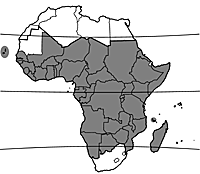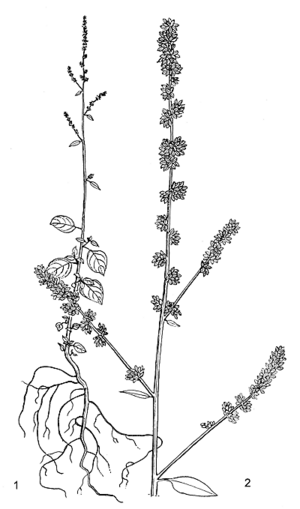Celosia trigyna (PROTA)
Introduction |
| General importance | |
| Geographic coverage Africa | |
| Geographic coverage World | |
| Vegetable | |
| Medicinal | |
| Forage / feed | |
| Food security | |
- Protologue: Mant. pl. 2: 212 (1771).
- Family: Amaranthaceae
- Chromosome number: 2n = 18
Synonyms
- Celosia laxa Schumach. & Thonn. (1827),
- Celosia digyna Suess. (1951).
Vernacular names
- Silver spinach, woolflower, cock’s comb (En).
- Célosie, crête de coq (Fr).
- Bóróbóró déo (Po).
- Mfungu (Sw).
Origin and geographic distribution
Celosia trigyna occurs almost throughout tropical Africa, also in South Africa and southern Arabia, often as a weed. It is recorded as a leafy vegetable in Benin and southern Nigeria, but also in South Africa. Celosia trigyna has been introduced in the United States, where it is locally naturalized.
Uses
Celosia trigyna leaves are consumed as a vegetable, finely cut in soups, stews and sauces. The slightly bitter leaves are popular amongst the Yoruba people in south-western Nigeria, where the plant is known as ‘aje fo wo’.
The plant is used in traditional medicine. In Sierra Leone it is used for the treatment of heart complaints, whereas in northern Nigeria it is used to treat pustular skin eruption. In Ghana it is applied to sores and boils. Pulped leaves are used to treat costal pains, chest troubles, stomach-ache and urethral disorders. The plant is included in several medicinal preparations used to treat women’s disorders and diseases, including ovarian troubles in DR Congo and excessive menstruation in Ethiopia. The leaves and flowers are used to treat diarrhoea. The plant is eaten by livestock, but reports on its acceptability are contradictory.
Production and international trade
Celosia trigyna is a minor vegetable sold in local and city markets. Production data are not available.
Properties
The nutritional composition of Celosia trigyna leaves per 100 g edible portion is: water 89 g, energy 138 kJ (33 kcal), protein 2.7 g, fat 0.4 g, carbohydrate 6.4 g, fibre 1.4 g, Ca 154 mg, P 32 mg, Fe 5.0 mg, ß-carotene 1.9 mg, riboflavin 0.1 mg, ascorbic acid 10 mg (Leung, W.-T.W., Busson, F. & Jardin, C., 1968).
Celosia trigyna has shown anthelmintic properties in humans; methanol extracts of the whole plant have shown acaricidal properties.
Adulterations and substitutes
Leaves of Celosia trigyna used in soups can be replaced by leaves of Celosia argentea L. and several Amaranthus species.
Description
- Erect annual herb up to 120(–180) cm tall; stem simple or branched, grooved or striate, glabrous or with few hairs, usually pinkish brown.
- Leaves alternate, simple, without stipules; petiole up to 5(–8) cm long; blade broadly ovate to narrowly lanceolate, (1–)2–8.5(–10) cm × (0.5–)1–4(–5) cm, tapering to truncate at base, acute to acuminate at apex, entire, glabrous or slightly shortly hairy below, pinnately veined.
- Inflorescence an axillary and terminal simple or branched spike 6.5–35 cm long, formed of distant or approximate clusters of flowers, bracteate, silvery to pink.
- Flowers small, bisexual, regular, 5-merous; tepals free, ovate-elliptical, 2–3 mm long, shortly mucronate; stamens fused at base; ovary superior, 1-celled, style very short, stigmas 2–3.
- Fruit an ovoid capsule c. 2 mm long, circumscissile, few-seeded.
- Seeds lenticular, c. 1 mm long, black and shining, shallowly reticulate.
Other botanical information
Celosia comprises about 50 species and occurs in all tropical and subtropical regions. Celosia trigyna is probably the most widespread species in tropical Africa. It differs from many other Celosia species in its chromosome number, being diploid, and is considered to have an isolated position within the genus.
Other species
Some other species are often confused with Celosia trigyna and these are probably used as a vegetable as well: Celosia globosa Schinz (found from Nigeria to Uganda), Celosia isertii C.C.Towns. (throughout tropical Africa except the north-eastern part), Celosia leptostachya Benth. (Sierra Leone to DR Congo) and Celosia pseudovirgata Schinz (Nigeria to DR Congo).
Growth and development
Seed germinates 4–5 days after sowing. The growing period is 90–120 days from planting to seed maturity. The flowers are pollinated by insects.
Ecology
Celosia trigyna occurs in forest clearings and grassland, along roadsides and rivers, and as a weed in fields, up to 1500(–2000) m altitude. It requires up to 2500 mm annual rainfall and maximum temperatures of 25–30°C for optimum growth, and does not tolerate temperatures below 15°C. It grows on a wide range of soils, but prefers fertile well-drained loamy soils.
Propagation and planting
Celosia trigyna is propagated by seed, which is either broadcast or drilled directly on plant beds. The seeds are small, the 1000-seed weight being about 0.3 g. A seed rate of 8 kg/ha is recorded as adequate. Before sowing, the seed is mixed with sand or finely sieved soil to achieve a uniform spread and good plant establishment. Broadcasting the seed is preferred for leaf production. Plants are thinned to a spacing of about 15 cm; they become very bushy with overhanging branches at wider spacings. Drilling in rows spaced 0.8–1.0 m apart is more suitable for seed production.
Management
Celosia trigyna requires fertile soils for proper growth. In poor or moderately fertile soil, incorporation of organic manure at a rate of 20–25 t/ha before planting is recommended. As an alternative, application of NPK (20–10–10) at 300–400 kg/ha is suitable for a single harvest by uprooting, whereas in case of repeated cutting a higher dose of 500–700 kg/ha can be applied. Weeding is essential at the early seedling stage and regular watering is required during dry periods.
Celosia trigyna often becomes weedy in other crops. It can be controlled fairly easily both mechanically and with herbicides.
Diseases and pests
Disease incidence is not common in Celosia trigyna and no records of serious diseases are available. Pests recorded include millipedes and the adults and larvae of the tortoise beetle (Cassida tosta), which feed on the leaves. In south-western Nigeria, a few destructive insects have been recorded on the plant. Adults of Gasteroclisus rhomboidalis attack the stem, and the leaves are attacked by adults of Anacatantops notatus. The larvae of Sceliodes laisalis and Hymenia recurvalis are destructive to the leaves.
Harvesting
Celosia trigyna can be harvested either by uprooting of young and vigorous seedlings or by repeated cutting. The first leaf harvest is about 8 weeks after sowing and up to 8 pickings of young shoots are possible in a period of 2 months before flowering reduces growth. Cutting of side branches and stems at 5 cm above soil level encourages branching.
Yield
Weekly harvest for a period of up to 2 months can yield about 4–5 t/ha of fresh vegetable.
Handling after harvest
Fresh leaves are used for home consumption or marketing directly after the harvest or dried for later use. Fresh stem and branches are tied into small bundles before they are taken to the markets for sale.
Genetic resources
Diversity within Celosia trigyna is considerable, but there is no information on attempts to collect, conserve and characterize the diversity. Improved cultivars are not available. There is no threat of genetic erosion in wild populations because Celosia trigyna is widespread and common in disturbed habitats.
Prospects
Celosia trigyna is currently of little importance as a leafy vegetable in comparison with Celosia argentea, but availability of genetically improved types and suitable agronomic practices could rapidly increase the production as a tasty leafy vegetable.
Major references
- Burkill, H.M., 1985. The useful plants of West Tropical Africa. 2nd Edition. Volume 1, Families A–D. Royal Botanic Gardens, Kew, Richmond, United Kingdom. 960 pp.
- Leung, W.-T.W., Busson, F. & Jardin, C., 1968. Food composition table for use in Africa. FAO, Rome, Italy. 306 pp.
- Mander, M., 1998. Marketing of indigenous medicinal plants in South Africa. A case study in Kwazulu-Natal. FAO, Rome, Italy. 151 pp.
- Townsend, C.C., 1985. Amaranthaceae. In: Polhill, R.M. (Editor). Flora of Tropical East Africa. A.A. Balkema, Rotterdam, Netherlands. 136 pp.
- Townsend, C.C., 1988. Amaranthaceae. In: Launert, E. (Editor). Flora Zambesiaca. Volume 9, part 1. Flora Zambesiaca Managing Committee, London, United Kingdom. pp. 28–133.
- Townsend, C.C., 2000. Amaranthaceae. In: Edwards, S., Mesfin Tadesse, Demissew Sebsebe & Hedberg, I. (Editors). Flora of Ethiopia and Eritrea. Volume 2, part 1. Magnoliaceae to Flacourtiaceae. The National Herbarium, Addis Ababa University, Addis Ababa, Ethiopia and Department of Systematic Botany, Uppsala University, Uppsala, Sweden. pp. 299–335.
- van Epenhuijsen, C.W., 1974. Growing native vegetables in Nigeria. FAO, Rome, Italy. 113 pp.
Other references
- Akinlosotu, T.A., 1983. Destructive and beneficial insects associated with vegetables in southwestern Nigeria. Acta Horticulturae 123: 217–230.
- Badra, T., 1993. Lagos spinach. In: Williams, J.T. (Editor). Pulses and vegetables: underutilized crops. Chapman & Hall, London, United Kingdom. pp. 131–163.
- Cavaco, A., 1974. Amaranthaceae. Flore du Cameroun. Volume 17. Muséum National d’Histoire Naturelle, Paris, France. 65 pp.
- Dupriez, H. & De Leener, P., 1989. African gardens and orchards, growing vegetables and fruits. MacMillan Press, London, United Kingdom. 333 pp.
- Eluwa, M.C., 1977. Studies on Gasteroclisus rhomboidalis, Coleoptera: Curculionidae, a pest of the African spinach. Journal of Natural History 11(4): 417–424.
- Gbile, Z.O., 1983. Indigenous and adapted African vegetables. Acta Horticulturae 123: 71–80.
- Lowe, J. & Soladoye, M.O., 1990. Some changes and corrections to names of Nigerian plants since publication of Flora of West Tropical Africa Ed. 2 and Nigerian trees. Nigerian Journal of Botany 3: 1–24.
- Townsend, C.C., 1975. The genus Celosia (subgenus Celosia) in tropical Africa. Hooker's Icones Plantarum 38: 1–123.
- Townsend, C.C., 1993. Amaranthaceae. In: Thulin, M. (Editor). Flora of Somalia. Volume 1. Pteridophyta; Gymnospermae; Angiospermae (Annonaceae-Fabaceae). Royal Botanic Gardens, Kew, Richmond, United Kingdom. pp. 140–167.
Sources of illustration
- Townsend, C.C., 1975. The genus Celosia (subgenus Celosia) in tropical Africa. Hooker's Icones Plantarum 38: 1–123.
Author(s)
- O.A. Denton, National Horticultural Research Institute, P.M.B. 5432, Idi-Ishin, Ibadan, Nigeria
Correct citation of this article
Denton, O.A., 2004. Celosia trigyna L. [Internet] Record from PROTA4U. Grubben, G.J.H. & Denton, O.A. (Editors). PROTA (Plant Resources of Tropical Africa / Ressources végétales de l’Afrique tropicale), Wageningen, Netherlands.
Accessed 1 June 2025.



